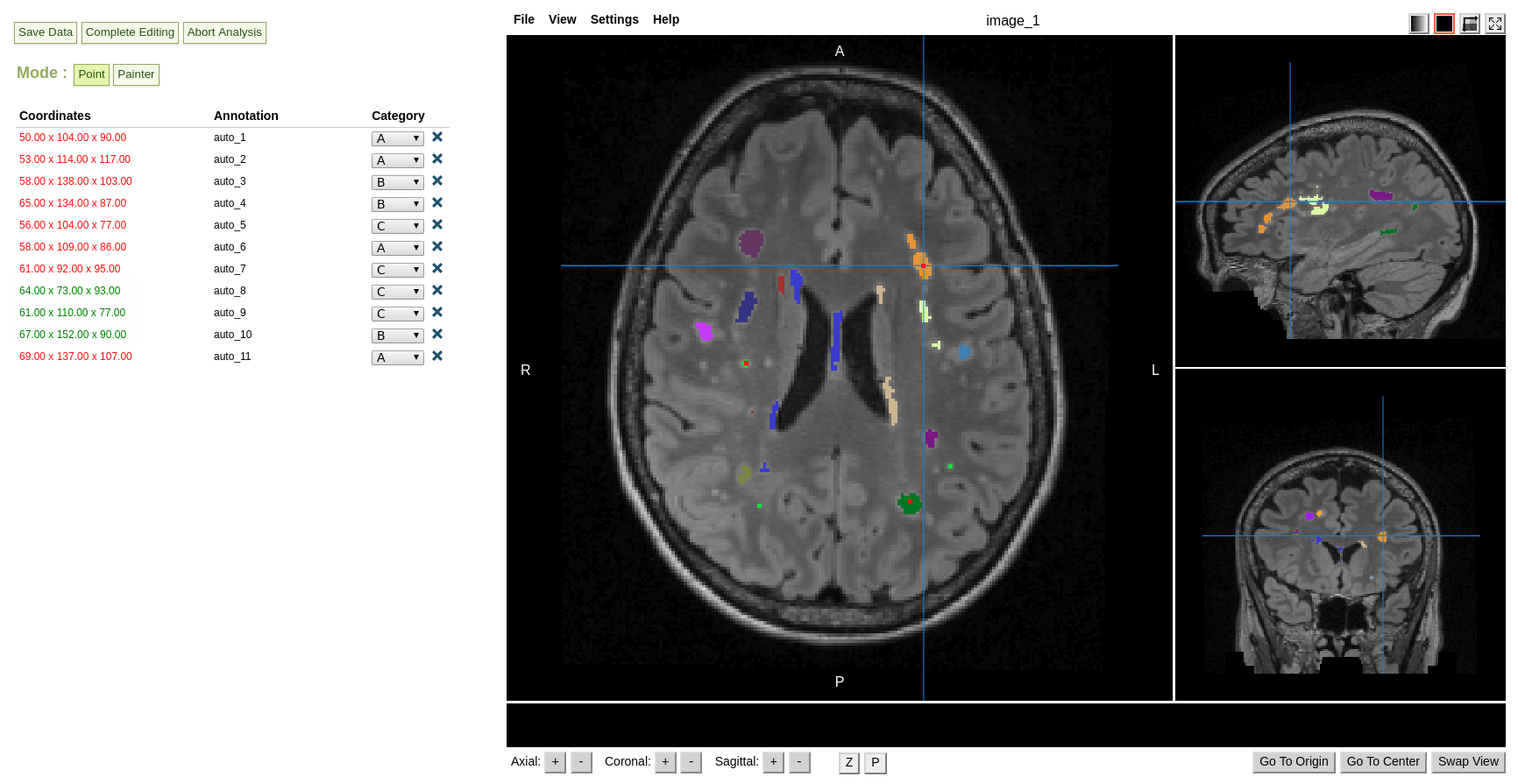Coordinate Annotation
This manual tool permits to pre-load coordinates and create new coordinates over a 3D image and annotate them, assigning them one of a definite set of tags. The number of coordinates of each category will be counted at the end of the annotation session.
View of the annotation tool with a mask overlay on the multi-planar view on the right and coordinate markups on the left.

Usage:
This tool allows for coordinate-wise annotation of images. The tool consists of a multi-planar viewer on the right side (for more information visit the Muti-planar neuro-radiological viewer article, a coordinate-markup list on the left side, and save/mode control buttons on the top.
The tool main functionality is operated through the "Point" mode. This is the default starting mode and provides semi-automatic curating of the lesion mask by allowing the user to mark false-positive and false-negatives and automatically adding or removing lesions mask on the marked coordinates.
If pre-computed coordinates were provided by the workflow, a set of coordinate markups will be readily available on the editing-markup list on the left. Coordinates in the mark-up list can be added a personalized annotation message, and assigned a category from the drop-down menu.
- New coordinate mark-ups can be created on the main slice view by pressing Shift+Left-click on the desired location. As a visual guide, if the location rests within the overlay mask, the coordinate will be coloured red, if the location rests outside the mask, the coordinate markup will be coloured green. Available categories may differ for "red" and "green" coordinates.
- Marked coordinates might be deleted by the user by pressing the "X" next to the category selection box.
Once the annotation stage is completed, additional metadata fields for the corresponding session will be added to My Data view, one per each available category, showing the final number of annotations assigned to each category.
Once the desired annotation has been completed, you may follow three paths by pressing the corresponding control button:
- Save Data: This will save all the current edits but will not finalize the annotation session. You may safely exit the too and the platform and come back at a later time to complete the process, several users might contribute in the same annotation session this way.
- Complete Editing: This will finalize the editing session, the desired changes will be applied/computed over the masks, and the analysis workflow will continue. This view may be later revisited to explore the exact edits / changes that were made, but they may not be modified further.
- Abort Analysis: This will abort the current session, and permanently terminate the corresponding analysis. Press this only if the QC was considered failed for some reason, and the image is not fit for further processing.
The "Painter" mode may be used to manually modify the overlay slice-wise through the annotation session.
Have in mind that these changes are intended to help the annotation session only. While these changes may be saved to keep throughout the session, the output mask will be a copy of the original input mask and will not include the changes made with the painter tool.
- In order to erase voxels from an existing overlay mask element, select the Color code: 0 (default). Then press and hold shift while you paint by left-click and dragging around the main view.
- In order to add voxels to an existing mask element, first check the mask ID by putting the cross-hairs/cursor over the desired element and looking at the ID value at the bottom of the main view. Input this ID as color code, and then paint by shit+left-click.
- In order to create a new mask element, select a high-value as color code (so that it does not correspond to an existing element) and paint in the same way as described above.
Inputs / Outputs
- Required inputs:
- Base image: Base image to show, usually a 3D anatomical image.
- Overlay: Overlay mask, should be a binary or labels file (integer values).
Must have same dimensions as base image.
- Optional inputs:
- Import points: list of annotation coordinates to be pre-loaded.
- Import points: list of annotation coordinates to be pre-loaded.
- Outputs:
- Images:
- BASE_IMAGE.nii.gz: a copy of the input base image, with matching name.
- OVERLAY.nii.gz: a copy of the input overlay image, with matching name.
- Images:
Typical execution time:
-
<1 minute (after user has completed manual process).
Create free account now!
